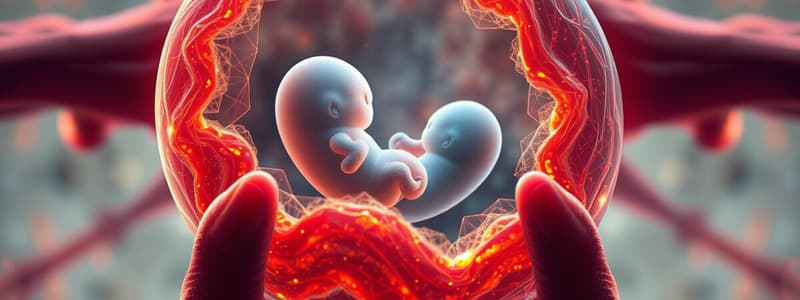Podcast
Questions and Answers
What is the role of Hox genes in embryonic development?
What is the role of Hox genes in embryonic development?
- They regulate cell differentiation.
- They determine the body plan along the anterior-posterior axis. (correct)
- They influence hormonal changes.
- They control the spacing of the embryo.
Which term describes an abnormality in the structure of chromosomes?
Which term describes an abnormality in the structure of chromosomes?
- Chromosomal number aberration (correct)
- Congenital infection
- Mutation
- Environmental factors
What period is characterized by major organ development in the embryo?
What period is characterized by major organ development in the embryo?
- Critical period
- Embryonic period (correct)
- Teratogenic period
- Fetal period
Which molecule is classified as a growth factor involved in embryonic development?
Which molecule is classified as a growth factor involved in embryonic development?
Which condition is characterized by the presence of fused toes or fingers?
Which condition is characterized by the presence of fused toes or fingers?
What is a common effect of teratogens during the critical period of development?
What is a common effect of teratogens during the critical period of development?
What does the term 'dysplasia' refer to in embryology?
What does the term 'dysplasia' refer to in embryology?
Which syndrome is characterized by cleft palate and other craniofacial anomalies?
Which syndrome is characterized by cleft palate and other craniofacial anomalies?
What is the primary function of the allantois during early development?
What is the primary function of the allantois during early development?
Which structure serves as the intermediate layer between the embryo and the placenta?
Which structure serves as the intermediate layer between the embryo and the placenta?
What is the primary cause of birth defects related to embryonic development?
What is the primary cause of birth defects related to embryonic development?
What process describes how neighboring cells influence each other during development?
What process describes how neighboring cells influence each other during development?
Which components make up the placenta?
Which components make up the placenta?
How do cells communicate to alter gene expression?
How do cells communicate to alter gene expression?
What aspect of embryo development is primarily governed by signaling pathways?
What aspect of embryo development is primarily governed by signaling pathways?
What role do growth factors play in embryonic development?
What role do growth factors play in embryonic development?
Why is understanding embryology important for physicians?
Why is understanding embryology important for physicians?
How does embryological development relate to maternal health?
How does embryological development relate to maternal health?
What is one of the ways embryology helps with clinical applications in training?
What is one of the ways embryology helps with clinical applications in training?
What is emphasized as a benefit of grasping developmental concepts in embryology?
What is emphasized as a benefit of grasping developmental concepts in embryology?
Which aspect of human anatomy development is described as a key focus in embryology?
Which aspect of human anatomy development is described as a key focus in embryology?
What does the approach to embryology emphasize for students in training?
What does the approach to embryology emphasize for students in training?
Why might embryology provide insights into congenital conditions?
Why might embryology provide insights into congenital conditions?
What fundamental aspect is explored to understand human anatomy through embryology?
What fundamental aspect is explored to understand human anatomy through embryology?
What type of injury is caused by a defective developmental process?
What type of injury is caused by a defective developmental process?
Which medication is associated with cognitive defects and potential death as teratogenic effects?
Which medication is associated with cognitive defects and potential death as teratogenic effects?
Which teratogen is known to interrupt normal development due to environmental factors?
Which teratogen is known to interrupt normal development due to environmental factors?
What type of abnormality is caused by extrinsic factors interfering with normal development?
What type of abnormality is caused by extrinsic factors interfering with normal development?
What is one of the effects of exposure to X-rays during development?
What is one of the effects of exposure to X-rays during development?
Which congenital infection agent is linked to preterm birth and macrosomia?
Which congenital infection agent is linked to preterm birth and macrosomia?
What injury type involves a normal developmental process being interrupted?
What injury type involves a normal developmental process being interrupted?
Which of the following is NOT a consequence of teratogen exposure from the options provided?
Which of the following is NOT a consequence of teratogen exposure from the options provided?
What is volvulus and how does it affect the gut?
What is volvulus and how does it affect the gut?
How long does human development typically take from fertilization to birth?
How long does human development typically take from fertilization to birth?
Which structure undergoes differentiation and looping during human embryonic development?
Which structure undergoes differentiation and looping during human embryonic development?
Why is 40 weeks often cited as a healthy full-term pregnancy?
Why is 40 weeks often cited as a healthy full-term pregnancy?
What can result from volvulus in developing gut regions?
What can result from volvulus in developing gut regions?
What is the significance of the flowchart of major human germ layer derivatives?
What is the significance of the flowchart of major human germ layer derivatives?
Which of the following is NOT a common result of looping during gut development?
Which of the following is NOT a common result of looping during gut development?
What should students focus on in their preclerkship work regarding embryonic structures?
What should students focus on in their preclerkship work regarding embryonic structures?
Flashcards are hidden until you start studying
Study Notes
Trophoblast Structures
- Cyto-trophoblast: Inner layer of trophoblast during early embryonic development.
- Syncytio-trophoblast: Outer layer of trophoblast, formed by the fusion of cytotrophoblasts, important for implantation and nutrient exchange.
Developmental Features
- Primitive streak: Structure that defines the future embryonic axes, initiates gastrulation.
- Node: Also known as Henson's node, a signaling center during embryonic development located at the anterior end of the primitive streak.
- Primitive groove: Depressed area in the primitive streak, facilitating cell migration during gastrulation.
- Notochord: Rod-like structure that provides support in embryonic development and contributes to the formation of the vertebral column.
Key Molecules and Genes
- Growth factors: Proteins that stimulate cell proliferation and differentiation.
- Transcription factors: Proteins that regulate the transcription of specific genes.
- Regulatory genes: Genes involved in the control of gene expression and development.
- Hox genes: Homeotic genes that determine the anterior-posterior axis and segment identity.
- Sonic hedgehog (Shh): Important signaling molecule for limb patterning and central nervous system development.
- Wnt family genes: Involved in cell signaling pathways that control cell fate and patterning.
- FGF family genes: Promote cell growth, differentiation, and embryonic development.
Hormonal Influences
- Human chorionic gonadotropin (hCG): Hormone produced during pregnancy, crucial for maintaining the corpus luteum and early pregnancy support.
Clinical Terminology
- Embryonic period: Key stage of development from fertilization to 8 weeks.
- Fetal period: Development phase from 9 weeks until birth.
- Mutation: Alteration in DNA sequence that may affect development.
- Chromosomal number aberration: Abnormal number of chromosomes, leading to various syndromes.
Developmental Abnormalities
- Critical period: Time frame when developing organs are susceptible to damage.
- Teratogen: Environmental agent that can cause congenital malformations.
- Congenital infection: Infections occurring in utero that can cause developmental issues.
- Malformation: Abnormal development due to intrinsic factors.
- Disruption: Abnormal development due to extrinsic factors interrupting normal processes.
- Deformation: Structural abnormality caused by mechanical forces.
- Aplasia: Absence of an organ or tissue due to inadequate developmental signals.
- Hypoplasia: Underdevelopment or incomplete development of an organ or tissue.
- Dysplasia: Abnormal organization of cells leading to structural abnormalities.
- Field defect: A developmental defect affecting a contiguous area.
- Syndrome: A set of medical signs and symptoms associated with a particular disease or condition.
- Sequence: A series of abnormalities stemming from a single primary defect.
- Association: A non-random occurrence of multiple defects that do not have a clear cause.
Specific Conditions
- Pierre-Robin Sequence: A condition characterized by a smaller jaw, cleft palate, and breathing difficulties.
- DiGeorge Syndrome: A genetic disorder affecting the development of several body systems, commonly leading to heart defects and immune deficiencies.
- Potter Sequence: A series of abnormalities due to oligohydramnios affecting fetal development.
- VACTERL Association: A group of congenital malformations including vertebral, anal, cardiac, tracheoesophageal, renal, and limb defects.
- Ectodermal Dysplasia: Group of disorders affecting the development of ectodermal structures like skin and teeth.
- Microcephaly: Condition characterized by a significantly smaller head size and impaired brain development.
- Treacher-Collins Syndrome: A genetic disorder affecting the development of bones and tissues in the face.
- Volvulus: Abnormal twisting of the intestine leading to obstruction and potential ischemia.
- Holoprosencephaly: Failure of the embryonic forebrain to divide into two hemispheres.
- Conjoined Twins: Twins physically connected at birth due to incomplete separation during early embryonic development.
- Twin-twin Transfusion Syndrome: Occurs in identical twins sharing a placenta, leading to imbalanced blood flow.
- Ectopic Pregnancy: A pregnancy occurring outside the uterus, typically in a fallopian tube.
- Situs inversus: A condition where major visceral organs are reversed or mirrored.
- Sacrococcygeal teratoma: Tumor at the base of the spine, often congenital.
- Spina Bifida: A neural tube defect where the spine does not close completely.
- Ectopia Cordis: A condition where the heart is located partially or totally outside of the chest.
- Gastroschisis: A defect in the abdominal wall leading to exposure of the intestines.
- Omphalocele: A defect where the intestines remain outside the abdominal cavity, covered by a thin membrane.
Developmental Mechanisms
- Embryonic signaling and morphogenesis are crucial for normal development.
- Cells communicate through gap junctions or adhesion molecules affecting gene expression and differentiation.
- Induction: Process by which neighboring cells influence the development of adjacent cells.
Relevant Teratogens and Pathogens
- ACE Inhibitors: Can cause renal failure and skull defects.
- Warfarin: Associated with bone defects and cognitive issues.
- Hepatitis B: Linked to preterm birth and larger-than-average babies.
- Varicella (Chickenpox): Can cause scars and neurological defects.
- X-Rays: Exposure can lead to microcephaly and cognitive delays.
Study Recommendations
- Familiarize with key developmental stages from fertilization to birth, approximately 38 weeks.
- Understand the implications of maternal health on embryological development.
- Recognize the critical periods for susceptibility to teratogens and other environmental factors.
Studying That Suits You
Use AI to generate personalized quizzes and flashcards to suit your learning preferences.



